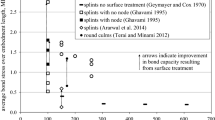Abstract
The study was conducted to determine the physical and mechanical properties as follows: modulus of rupture, modulus of elasticity, internal bond, thickness swelling and water absorption of oriented strand lumber (OSL) made from the Asian bamboo Dendrocalamus asper Backer. Thirty-six lab boards were produced from these bamboo strands with two manufacturing parameters varying, i.e., four resin types (MF, MUPF, PF, and pMDI) and three levels of resin content (7, 10, and 13%). The results indicate that OSL made from bamboo strands exhibits superior strength properties compared to the commercial products made from wood for the building sector. The resin type has a significant effect on board properties. Moreover, all properties of the board improve generally with increasing resin content. With regard to the internal bond, bamboo-based OSL shows less strength than wood-based boards. The best results were obtained by using 13% pMDI content at 750 kg\( / \)m3 density.
Zusammenfassung
Ziel der Studie war die Bestimmung folgender physikalischer und mechanischer Eigenschaften von Furnierstreifenholz (Oriented Strand Lumber -OSL) aus der asiatischen Bambusart Dendrocalamus asper Backer: Biegefestigkeit, Elastizitätsmodul, Querzugfestigkeit, Dickenquellung und Wasseraufnahme. Im Technikum wurden 36 Platten aus Bambusflachspänen (Strands) hergestellt, wobei zwei der Herstellungsparameter, d. h. Bindemitteltyp und -anteil, variiert wurden. Verwendet wurden vier verschiedene Bindemittel (MF, MUPF, PF und pMDI) in jeweils drei verschiedenen Beleimgraden (7, 10, 13%). Die Ergebnisse zeigen, dass OSL aus Bambusstrands bessere Festigkeitseigenschaften aufweist als aus Holz gefertigte, kommerziell erhältliche Produkte für den Baubereich. Der Bindemitteltyp hat einen signifikanten Einfluss auf die Platteneigenschaften. Generell verbessern sich die untersuchten Eigenschaften mit der Erhöhung des Bindemittelanteils. Die Querzugfestigkeit von OSL aus Bambus ist geringer als die von holzbasierten Platten. Die besten Eigenschaften wurden mit dem Einsatz von 13% pMDI bei einer Rohdichte von 750 kg\( / \)m3 erzielt.






Similar content being viewed by others
References
ASTM D 1037 (1997) Standard Test Methods for Evaluating Properties of Wood-based Fiber and Particle Panel Materials
ASTM D 5456 (1999) Standard Specification for Evaluation of Structural Composite Lumber Products
Barnes D (2000) An integrated model of the effect of processing parameters on the strength properties of oriented strand wood products. Forest Prod J 50(11/12):33–42
Bowyer J, Shmulsky R, Haygreen JG (2003) Forest products and wood science: An introduction 4th edition, Iowa State Press, Iowa, USA
Chen GH (1985) Bamboo plywood: A new product of structural material with high strength properties. In: Proceedings of the 2nd International Bamboo Workshop, Hang Zhou, Republic of China, pp 337–338
EN 300 (1997) Oriented Strand Boards (OSB) – Definitions, classification and specifications
Hague J, McLauchlin A, Quinney R (1998) Agri-material for panel products: a technical assessment of their viability. In: 32nd International Particleboard/Composite Materials Symposium Proceedings, Pullman, Washington, pp 151–159
ICBO (2002) Acceptance Criteria for Structural Composite lumber. International Conference of Building Official Evaluation Service Inc, USA
Lee AWC, Bai X, Peralta PN (1996) Physical and mechanical properties of strandboard made from moso bamboo. Forest Prod J 46(11/12):84–88
Lee AWC, Bai X, Bang AP (1997) Flexural properties of bamboo-reinforced southern fine OSB beams. Forest Prod J 47:74–78
Liese W (1985) Bamboos-biology, silvics, properties, utilization. Deutsche Gesellschaft für Technische Zusammenarbeit (GTZ) GmbH, Eschborn, Germany
Maloney TM (1993) Modern particleboard and dry-process fiberboard manufacturing (updated edition). Miller Freeman, San Francisco
Nugroho N, Ando N (2000) Development of structural composite products made from bamboo I: fundamental properties of bamboo zephyr board. J Wood Science 46:68–74
Nugroho N, Ando N (2001) Development of structural composite products made from bamboo II: fundamental properties of laminated bamboo lumber. J Wood Science 47:237–242
Pakhkeree T (1997) Physical and mechanical properties of Dendrocalamus asper Becker. Dissertation, Kasetsart University, Thailand
Paul W, Ohlmeyer M, Leihoff H, Boonstra MJ, Pizzi A (2006) Optimizing the properties of OSB by a one-step heat pre-treatment process. Holz Roh- Werkst 64:227–234
Pizzi A (1994) Advanced Wood Adhesives Technology. Marcel Dekker Inc., New York Basel Hong Kong
Post PW (1958) Effect of particle geometry and resin content on bending strength of oak flake board. Forest Prod J 8(10):317–322
Sauter SL (1996) Developing composites from wheat straw. In: 30th International Particleboard/Composite Materials Symposium Proceedings, Pullman, Washington, USA pp. 197–214
Sumardi I, Ono K, Suzuki S (2007) Effect of board density and layer structure on the mechanical properties of bamboo oriented strandboard. J Wood Science 53:510–515
Sumardi I, Kojima Y, Suzuki S (2008) Effects of strand length and layer structure on some properties of strandboard made from bamboo. J Wood Science 54:128–133
USDA Forest Service (1999) Wood Handbook: Wood as an Engineering Material. USDA gen. Tech. Rept. FPL-GTR-133
Zhang HJ (2001) A new structural panel composite: Bamboo-based waferboard. In: Proceedings of the Utilization of Agricultural and Forestry Residues, Nanjing, Republic of China, pp 204–209
Acknowledgements
The authors gratefully acknowledge the German Academic Exchange Service (DAAD), the Von Thünen Federal Research Institute Hamburg and the Department of Wood Science University of Hamburg for the available research equipment and financial support. Also a special thank goes to the Wood Science and Engineering Research Unit, Walailak University, Thailand for providing the raw material and facilities for the experimental work.
Author information
Authors and Affiliations
Corresponding author
Rights and permissions
About this article
Cite this article
Malanit, P., Barbu, M.C. & Frühwald, A. Physical and mechanical properties of oriented strand lumber made from an Asian bamboo (Dendrocalamus asper Backer). Eur. J. Wood Prod. 69, 27–36 (2011). https://doi.org/10.1007/s00107-009-0394-1
Received:
Published:
Issue Date:
DOI: https://doi.org/10.1007/s00107-009-0394-1




